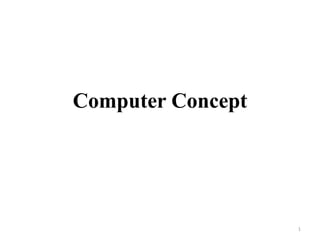
Computer Concepts Guide
- 2. Chapter Content • Knowledge about computer • Knowledge about hardware and software • Knowledge about different types of computer • Knowledge about first generation, second generation, third generation, fourth generation and fifth generation computer 2
- 3. What is Computer? • an electronic device that manipulates information or data. • has the ability to store, retrieve, and process data. 3
- 4. Use of a computer • type documents • send email • browse the Web • handle spreadsheets • Accounting • database management • Presentations • games 4
- 5. Basic parts of Computer All types of computers consist of two basic parts: • Hardware - physical structure, such as the computer monitor or keyboard • Software - set of instructions that tells the hardware what to do. Example: web browsers, games, and word processors such as Microsoft Word 5
- 7. Figure: Microsoft Office Word 7
- 8. Different types of computers 1.Desktop computers: – Use at work, home, school, or the library – small, medium, or large in style, and they usually sit on a desk – Once you add a monitor, mouse, and keyboard, you have what is typically known as a desktop computer – easy to upgrade and expand or add new parts – desktop computer is priced lower – Some desktop computers have a built-in monitor to save space. These are often called all-in-one desktop computers. 8
- 10. Different types of computers(cont.) 2.Laptop computers: – Laptops are battery- or AC-powered personal computers – more portable than desktop computers – may not be able to upgrade them as easily as a desktop – it's usually possible to add more RAM or a larger hard drive 10
- 12. Different types of computers(cont.) 3.Servers: – serves up information to other computers on a network – look like a regular desktop computer, or it can be much larger – WebPages are stored 12
- 14. 4. Tablet computers – use a touch-sensitive screen for typing and navigation – don't require a keyboard or mouse – more portable than laptops – The iPad is an example of a tablet computer 14
- 16. PCs and Macs Personal computers come in two main styles: • PC: – began with the original IBM PC that was introduced in 1981 – this is the most common type of personal computer today – typically includes the Microsoft Windows operating system 16
- 17. PCs and Macs (Cont.) • Mac: – Macintosh computer was introduced in 1984 – first widely sold personal computer with a Graphical User Interface – made by one company, Apple Inc. – use the Mac OS operating system 17
- 19. Figure: Mac 19
- 20. Summary – The computer – electronic device that can store, retrieve, and process data. – Hardware – physical structure of the computer. – Software – set of instructions that tell the hardware what to do. – Desktop computers – personal computer designed for regular use at a single location on or near a desk or table due to its size and power requirements. – Laptop computers - a computer that is portable and suitable for use while travelling. – Server Computers - used to manage network resources. – Tablet computers - small portable computer that accepts input directly on to its screen rather than via a keyboard or mouse. – PCs – personal computer began with the original IBM PC that was introduced in 1981. It typically includes the Microsoft Windows operating system. – Macs - Macintosh computer introduced in 1984. Made by one company Apple Inc., and they almost always use the Mac OS X operating system. 20
- 21. Exercise 1.1 • What is computer? • Define software and hardware with two examples. • Write down about the basic parts of a computer. • What is the difference between desktop and laptop computer. • Explain about different types of a computer. • Write down about PCs and Macs computer. • What is server computer? 21
- 22. Critical Thinking 1.1 1. List the activities you perform using a computer. 2. Which type of computer do you think is the best for you: a desktop computer, a laptop, a tablet, or a phone? Give a reason for your answer. 22
- 23. Generations of Computer • the state of improvement in the product development process • miniaturization, speed, power, and computer memory has proportionally increased • affect the way we live, work and play • fundamentally changed the way computers operate, resulting in increasingly smaller, cheaper and more powerful and more efficient and reliable devices. 23
- 24. Generations of Computer 1. First Generation - 1940-1956: Vacuum Tubes 2. Second Generation - 1956-1963: Transistors 3. Third Generation - 1964-1971: Integrated Circuits 4. Fourth Generation - 1971-Present: Microprocessors 5. Fifth Generation - Present and Beyond: Artificial Intelligence 24
- 25. Figure: First Generation Computer ENIAC using Vacuum Tubes 25
- 26. Fig: Second Generation computer 26
- 27. Third Generation Computer IBM-360 using Integrated Circuits 27
- 28. Fourth Generation Computer using Microprocessors 28